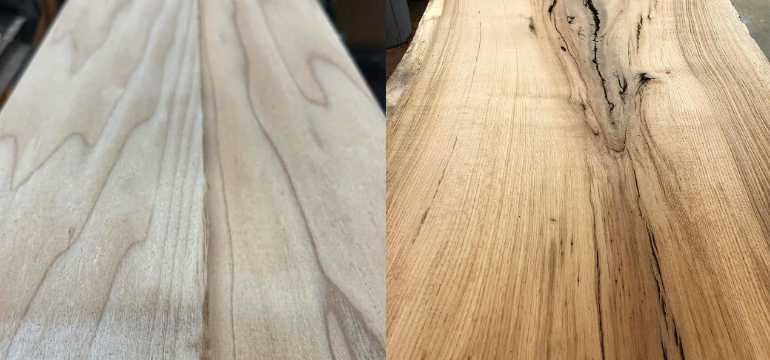Are you about to take on a woodworking project? Perhaps you’re crafting trim for your home, building some furniture, assembling cabinetry, or doing some other type of project that involves wood. When you are first starting out, it can be tough to determine what type of wood is best for your project.
There are so many varieties of both hardwood and softwood, and not all of them are suitable for every use. It’s a good idea to do plenty of research to find out what types of wood other people have used for the specific items or projects you are considering. In this guide, we will look at poplar vs. oak.
Poplar and oak are two popular kinds of wood often employed by DIYers for various home uses. Once you have a thorough understanding of the benefits and drawbacks of poplar vs. oak, you’ll be better prepared to make the right choice for your upcoming job.
Poplar vs. Oak

Strength
For the purposes of this guide, we are going to talk specifically about red oak and poplar. When you are deciding which type of wood to use, one of your key considerations is likely going to be the strength of the wood. To determine poplar vs. oak strength, we first need to look at the Janka scale; a scale used to rate the hardness of various types of lumber. The Janka scale rates for density, which is a key factor in durability.
White and yellow poplar are hardwoods, but they are among the softest of the hardwoods. They rank fairly low, with a hardness of 540 pound-feet (lb-ft). By contrast, red oak comes in at a powerful 1290 lb-ft on the Janka scale. For perspective, consider that Brazilian walnut is at the very top of the Janka scale, with a peak hardness of 3684.
What do these numbers mean, exactly? Well, the 1290 rating for red oak means that it is denser and heavier than poplar. It’s tougher to dent or damage. However, that very same density comes with a drawback. Red oak can be more brittle than yellow poplar, which means it is a bit more susceptible to shattering or cracking when placed under bending force. Poplar, due to its softness and lower density, can bend further before breaking or shattering.
So if you’re asking, “Is poplar wood strong?” the answer depends on the type of force it’s being subjected to. Under normal wear and tear, or blunt impact, oak is the champion. But when it comes to torsion or warping forces, poplar will last longer.
Appearance
 Poplar is typically a pale wood, an off-white streaked with yellow or green. More yellow or green streaks indicate slightly more hardness, but they also indicate that the wood will be much harder to stain. Poplar has a minimal grain, smooth and straight. Red oak stains beautifully, with rich, deep color and a nice grain. If you’re planning to stain the wood, red oak is best, although poplar can be stained if it is first subjected to a lengthy conditioning process.
Poplar is typically a pale wood, an off-white streaked with yellow or green. More yellow or green streaks indicate slightly more hardness, but they also indicate that the wood will be much harder to stain. Poplar has a minimal grain, smooth and straight. Red oak stains beautifully, with rich, deep color and a nice grain. If you’re planning to stain the wood, red oak is best, although poplar can be stained if it is first subjected to a lengthy conditioning process.
Cost
As always, the cost is often a determining factor for homeowners, woodworkers, and DIYers. Red oak costs more than poplar, so if you’re just looking for the cheapest thing with which to build your project, you should go with poplar. Pine is even cheaper but can be tricky to work with because of its knots and sap.
Workability
Since red oak is harder and denser, it’s tough to mill or sand than poplar is. Thanks to its resilience, poplar is fairly simple to machine, drill, nail, and cut using regular tools and common steel blades. If you’re working with red oak, you’ll need tougher, sharper, more expensive blades to effectively work on it; we’d recommend carbide-tipped blades.
While poplar can often be sanded by hand if it attains imperfections during the work process, red oak is usually too hard for you to sand out any serious scratches or gouges. You would have to use a power sander rather than doing it manually. If you’re planning to carve the wood, definitely go with poplar as the softer choice that is far easier to manipulate with hand tools.
Summary: Poplar vs. Oak
So there you have it: poplar may be a decently tough wood, but it can have ugly greenish or yellowish streaks, and unless you pre-condition it, it won’t take stain well. Due to its softness, you’ll either have to go through a long pre-stain process or paint the item once you’re done crafting it.
By contrast, oak is much harder and better looking, and it stains well, so the extra expense you will incur by choosing it may be worth your while. If you are looking to craft a long-lasting piece of furniture, invest in red oak as your material of choice.
- How to Cut Lexan - September 25, 2020
- Mineral Spirits vs. Mineral Oil - September 25, 2020
- Shellac vs. Polyurethane - September 24, 2020
